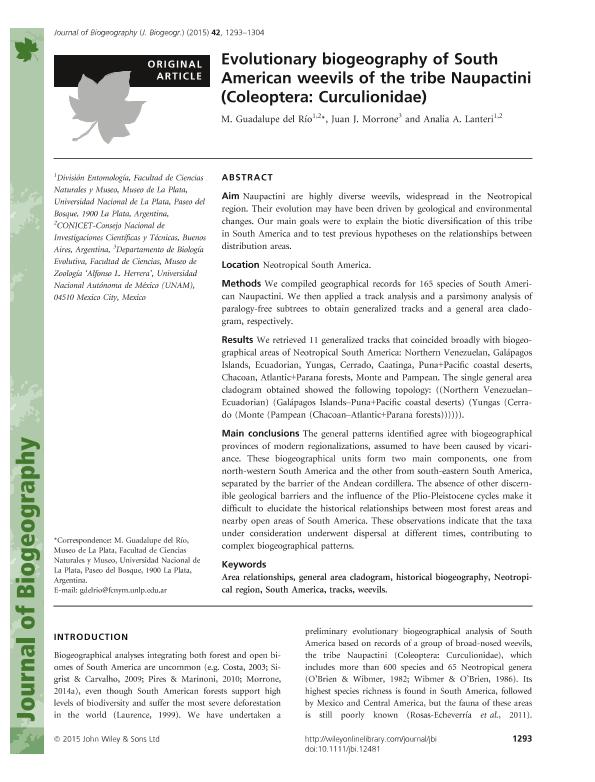Mostrar el registro sencillo del ítem
dc.contributor.author
del Rio, Maria Guadalupe

dc.contributor.author
Morrone, Juan José

dc.contributor.author
Lanteri, Analía Alicia

dc.date.available
2018-06-25T18:23:19Z
dc.date.issued
2015-07
dc.identifier.citation
del Rio, Maria Guadalupe; Morrone, Juan José; Lanteri, Analía Alicia; Evolutionary biogeography of South American weevils of the tribe Naupactini (Coleoptera: Curculionidae)
; Wiley Blackwell Publishing, Inc; Journal of Biogeography; 42; 7; 7-2015; 1293-1304
dc.identifier.issn
0305-0270
dc.identifier.uri
http://hdl.handle.net/11336/49964
dc.description.abstract
Aim: Naupactini are highly diverse weevils, widespread in the Neotropical region. Their evolution may have been driven by geological and environmental changes. Our main goals were to explain the biotic diversification of this tribe in South America and to test previous hypotheses on the relationships between distribution areas. Location: Neotropical South America. Methods: We compiled geographical records for 165 species of South American Naupactini. We then applied a track analysis and a parsimony analysis of paralogy-free subtrees to obtain generalized tracks and a general area cladogram, respectively. Results: We retrieved 11 generalized tracks that coincided broadly with biogeographical areas of Neotropical South America: Northern Venezuelan, Galápagos Islands, Ecuadorian, Yungas, Cerrado, Caatinga, Puna+Pacific coastal deserts, Chacoan, Atlantic+Parana forests, Monte and Pampean. The single general area cladogram obtained showed the following topology: ((Northern Venezuelan-Ecuadorian) (Galápagos Islands-Puna+Pacific coastal deserts) (Yungas (Cerrado (Monte (Pampean (Chacoan-Atlantic+Parana forests)))))). Main conclusions: The general patterns identified agree with biogeographical provinces of modern regionalizations, assumed to have been caused by vicariance. These biogeographical units form two main components, one from north-western South America and the other from south-eastern South America, separated by the barrier of the Andean cordillera. The absence of other discernible geological barriers and the influence of the Plio-Pleistocene cycles make it difficult to elucidate the historical relationships between most forest areas and nearby open areas of South America. These observations indicate that the taxa under consideration underwent dispersal at different times, contributing to complex biogeographical patterns.
dc.format
application/pdf
dc.language.iso
eng
dc.publisher
Wiley Blackwell Publishing, Inc

dc.rights
info:eu-repo/semantics/openAccess
dc.rights.uri
https://creativecommons.org/licenses/by-nc-sa/2.5/ar/
dc.subject
Area Relationships
dc.subject
General Area Cladogram
dc.subject
Historical Biogeography
dc.subject
Neotropical Region
dc.subject
South America
dc.subject
Tracks
dc.subject
Weevils
dc.subject.classification
Otras Ciencias Biológicas

dc.subject.classification
Ciencias Biológicas

dc.subject.classification
CIENCIAS NATURALES Y EXACTAS

dc.title
Evolutionary biogeography of South American weevils of the tribe Naupactini (Coleoptera: Curculionidae)
dc.type
info:eu-repo/semantics/article
dc.type
info:ar-repo/semantics/artículo
dc.type
info:eu-repo/semantics/publishedVersion
dc.date.updated
2018-06-25T12:36:20Z
dc.journal.volume
42
dc.journal.number
7
dc.journal.pagination
1293-1304
dc.journal.pais
Reino Unido

dc.journal.ciudad
Londres
dc.description.fil
Fil: del Rio, Maria Guadalupe. Universidad Nacional de La Plata. Facultad de Ciencias Naturales y Museo. División Entomología; Argentina. Consejo Nacional de Investigaciones Científicas y Técnicas; Argentina
dc.description.fil
Fil: Morrone, Juan José. Universidad Nacional Autónoma de México; México
dc.description.fil
Fil: Lanteri, Analía Alicia. Universidad Nacional de La Plata. Facultad de Ciencias Naturales y Museo. División Entomología; Argentina. Consejo Nacional de Investigaciones Científicas y Técnicas; Argentina
dc.journal.title
Journal of Biogeography

dc.relation.alternativeid
info:eu-repo/semantics/altIdentifier/doi/http://dx.doi.org/10.1111/jbi.12481
dc.relation.alternativeid
info:eu-repo/semantics/altIdentifier/url/https://onlinelibrary.wiley.com/doi/abs/10.1111/jbi.12481
Archivos asociados
